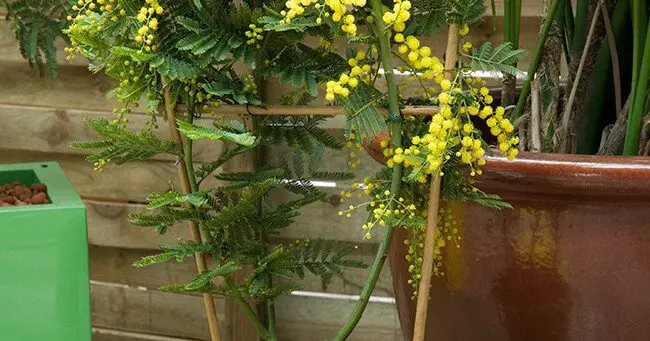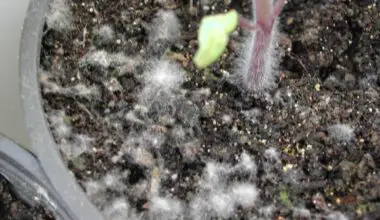The mimosa is a tree that seduces by its abundant flowering scented in small yellow pompoms at the end of winter. And if it is emblematic of the Mediterranean regions, it is because this small tree is rather cold and does not bear the cold well.
But, rest assured, if you live north of the Loire and far from the Atlantic coast, there is a solution: grow the mimosa indoors to shelter it from the cold in winter.
Planting an indoor potted mimosa is also a good option if you don’t have a garden, because, what better way to make a terrace bloom and perfume?
Contents
A mimosa indoors: under what conditions?
Native to Australia, the mimosa (Acacia dealbata and other species of the genus Acacia) is not very hardy. In order to avoid frost in the coolest regions, it must be grown indoors in pots to keep it warm during the winter.
A greenhouse, a veranda or a winter garden without frost will do the trick perfectly to install your mimosa as soon as the first frost comes and it will be well sheltered, especially since in pot, it will not exceed 2.5 meters in height.
Growing mimosa in pots indoors does not prevent it from flowering, but to do so, it should be exposed to at least 4 hours of full sunlight per day, think about it and place it in a warm and sunny area.
Another detail before starting to grow indoor mimosa, be aware that it will certainly flower indoors (except for the varieties of the 4 seasons), so check that no one is allergic to its pollen before installing it in your home. If the sun is there, that a shelter is available in winter and that nobody is allergic, go for it! Its golden and deliciously scented beads will delight you!
Which pot to choose for an indoor mimosa?
In order to successfully grow a potted mimosa, a suitable container must be chosen. The mimosa does not need a pot that is too wide because it will flower better if it feels a little cramped, however, choose a container that is deep enough because its roots are important. Plant it in a pot that is a third to twice the size of the root ball.
An unglazed terracotta or orangery container of 17 to 22 inches in diameter will suffice for an adult plant about 1 ft high. Make sure that the bottom of the container is well pierced, as the mimosa does not appreciate stagnant water!
Which potting soil to use for a potted mimosa?
Mimosa needs a very draining, fertile and light mixture at the same time. It will grow best in a slightly acidic substrate.
Make a mixture of half heather soil and topsoil or not too rich soil, add a handful of river sand to make the substrate sufficiently draining.
How to take care of an indoor potted mimosa
Here are a few simple cares to keep it for a long time!
Watering the indoor mimosa
Watering the mimosa indoors is essential, especially during the vegetative period (about once or twice a week). In pots, the substrate dries out more quickly than in the open ground. It must remain fresh but never waterlogged, at the risk of suffocating its roots and simply killing it.
- In summer: water moderately every day, preferably in the evening, especially in hot weather: the rootball should not dry completely between 2 waterings.
- In winter: it requires more limited watering. Water once a week, never letting the water stagnate in the cup.
Caution: Do not use a water tank or saucer under the pots, except in July and August for the latter.
Fertilization of indoor mimosa
Not very greedy in the open ground, Mimosa can nevertheless benefit from being fertilized when it is grown in pots. Give it a flowering plant fertilizer every two weeks mixed with water from March-April to September.
Indoor mimosa pruning
After flowering, slightly shorten the flowering branches by about half their length to keep a denser habit and flowering branches.
Repotting a mimosa
It is advisable to repot a mimosa every 2 years in the spring after flowering in a slightly larger container but proportionate to the size of the tree. If the pot is too heavy to handle, simply resurface each year:
- Scratch the earth on the surface for a few centimeters.
- Replace the extracted soil with a mixture of compost and crushed horn, respecting the level of the mimosa’s collar.
- Water abundantly
How to carve a mimosa indoors?
The pruning of the indoor mimosa is practiced after flowering. It is then necessary to prune the deflowered stems and to give balance to the silhouette of the tree. Cut the dead stems and those that cross in the center of the plant to let in a maximum of air and light, this will prevent pests from finding a particularly pleasant home in the plant clutter.
If by chance some scale insects are present, spray with black soap and remove them manually with a cloth.
Summary
In areas where climatic conditions do not allow the establishment of a mimosa in the open ground and in all regions, or if you are not lucky enough to own a garden. This form of indoor pot cultivation is quite feasible, we explain how to proceed from A to Z.









